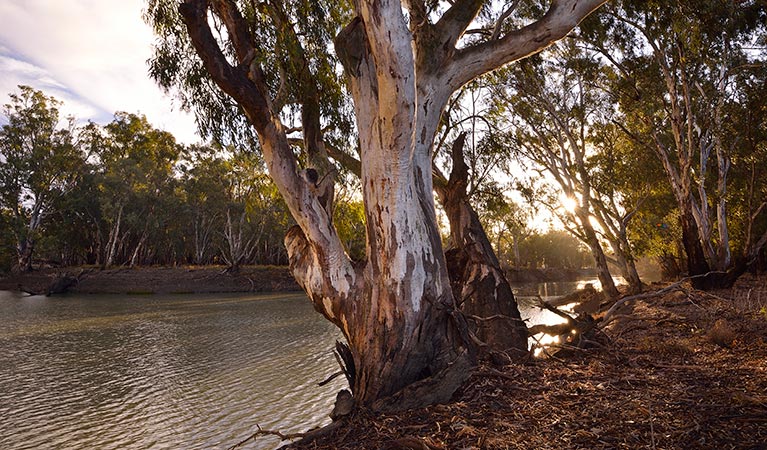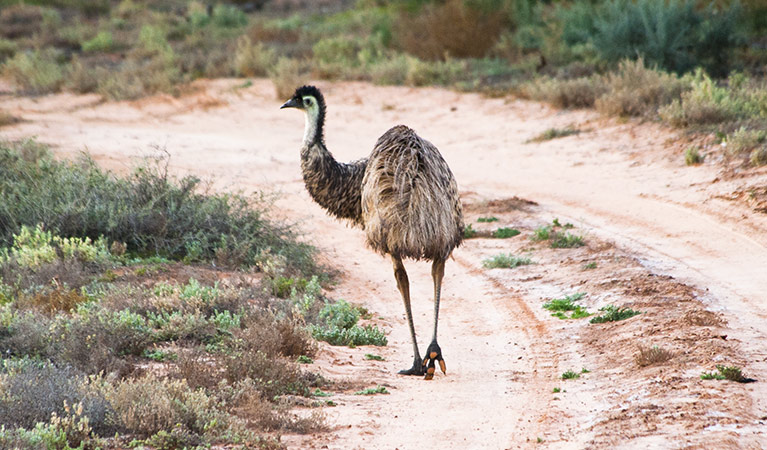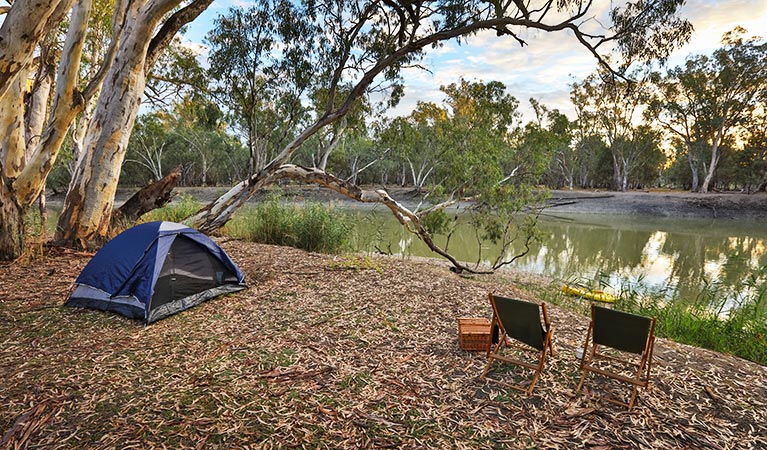Overview
Woolpress Bend campground in Yanga National Park offers secluded camping on the banks of the Murrumbidgee River. Spend your days paddling, fishing, birdwatching or explore the history of this remote and beautiful park.
| Number of campsites | 6 |
|---|---|
| Camping type | Tent, Camper trailer site, Camping beside my vehicle and Off-road caravan site |
| Facilities | Toilets, unpowered sites, unmarked sites |
| What to bring | Cooking water, drinking water, fuel stove |
| Price | There are no camping fees at this campground but a $6 booking fee applies. |
| Bookings | Book up to 12 people or 2 sites online. |
| Group bookings | This campground is not suitable for group bookings. |
| Please note |
|
Named after the steam press that produced bales of wool at this site in the 1850s, Woolpress Bend campground is a place of rich pastoral heritage and natural beauty.
Set up your tent, camper trailer or caravan by the Murrumbidgee River. You’ll soon settle into the relaxed pace of this remote spot in Yanga National Park. Join the kids for a swim in the river, or throw in a fishing line as the sun sets over the red gum wetlands.
It’s a haven for birdlife, including pelicans, grey-crowned babblers and brown treecreepers. Watch as kangaroos, emus and swamp wallabies roam the saltbush plains or come down to the river to drink.
Nearby, you’ll find Wollpress Bend picnic area with the remains of the original woolpress. Cook up a hearty breakfast, before going on a walk or paddle along the river.
On the way back to Balranald, stop in at Yanga Woolshed for a self-guided tour of the authentic 19th century woolshed with pretty river views.
Map

Map legend

Local alerts
For the latest updates on fires, closures and other alerts in this area, see https://www.nationalparks.nsw.gov.au/camping-and-accommodation/campgrounds/woolpress-bend-campground/local-alerts
Bookings
- National Parks Contact Centre
- 7am to 7pm daily
- 1300 072 757 (13000 PARKS) for the cost of a local call within Australia excluding mobiles
- parks.info@environment.nsw.gov.au
Operated by
- Yanga National Park office
- 8.30am to 4.30pm daily.
- 03 5021 8988
- npws.lowerdarling@environment.nsw.gov.au
- 38773 Sturt Highway, Balranald NSW 2715
Park info
- in Yanga National Park in the Murray-Riverina region
Yanga National Park is open Sunrise to Sunset but may have to close at times due to poor weather or fire danger.
Yanga Homestead Precinct is open 8.30am - 4.30pm.
Visitor info
All the practical information you need to know about Woolpress Bend campground.
Getting there and parking
Woolpress Bend campground is in the northern area of Yanga National Park. To get there:
From Balranald:
- Take Sturt Highway east for 10.5km
- Turn north onto Waugorah Road and continue around 44km (after the first 22km roads are unsealed)
- At the intersection with the old fridge mailboxes, turn left onto Coates Road
- Continue 5km, crossing the bridge over Waugorah Creek then keeping right onto Waugorah trail
- Then turn left at the information shelter onto Woolpress Bend trail and follow 4km to the campground.
Road quality
- Mixture of sealed and unsealed roads
Vehicle access
- 2WD vehicles
Weather restrictions
- Dry weather only
Parking
Parking is available at Woolpress Bend campground.
Facilities
- Water is not available at this campground.
- There are no rubbish bins, so please take your rubbish with you when you leave.
- Gas and fuel stoves are recommended as there are no designated barbecues or fire rings at the campground.
Toilets
- Non-flush toilets
Types of sites
- Unpowered sites
- Unmarked sites
Maps and downloads
Accessibility
Disability access level - hard
Wheelchairs can access this area with some difficulty
Permitted
Camp fires and solid fuel burners
Campfires are permitted on the ground at the campground, except during park or total fire bans (generally 1 October to 31 March). BYO firewood. Gas stoves are recommended in summer.
Cycling
Fishing
A current NSW recreational fishing licence is required when fishing in all waters.
Generators
Prohibited
Recreational hunting in NSW National Parks is an illegal activity and is a fineable offence.
Gathering firewood
Pets
Pets and domestic animals (other than certified assistance animals) are not permitted. Find out which regional parks allow dog walking and see the pets in parks policy for more information.
Smoking
NSW national parks are no smoking areas.
Learn more
Woolpress Bend campground is in Yanga National Park. Here are just some of the reasons why this park is special:
A pioneering history

Some of the country's renowned early explorers passed through this area, and you have the opportunity to retrace their steps. Explorers included John Oxley in 1817, Charles Sturt in 1830, Major Thomas Mitchell in 1836 and Burke and Wills in 1860. Visit nearby Balranald to see where Bourke and Wills' party crossed the Murrumbidgee by the Mayall Street punt, then camped by the river in front of Balranald Inn.
- Yanga Woolshed Explore Yanga Woolshed in Yanga National Park. When constructed in the late 1800s, the woolshed was the Riverina’s largest. It offers an insight into Australia’s pastoral history.
- Yanga Woolshed picnic area Located in Yanga National Park, near Balranald in the Riverina, Yanga Woolshed picnic area is an excellent place for a barbecue or spot of fishing on the Murrumbidgee.
A remarkable landscape

Yanga National Park is blessed with 170km of Murrumbidgee River frontage. The river is great for canoeing or swimming, and its banks provide excellent fishing and camping spots. On your visit, you'll notice the landscape's unique contrast of black and red country. Vegetation on its black soil floodplains comprises river red gum forest and swampland, while its red soil varies from grass to saltbush to woodlands. Come and spot the differences yourself.
- Regatta Beach picnic area Enjoy swimming, boating, birdwatching and paddling in the tranquil lakeside waters of picturesque Regatta Beach picnic area in Yanga National Park, near Balranald.
Rich in Aboriginal culture

Yanga National Park has a rich Aboriginal history; the park provided resources including waterbirds, fish, and yabbies as well as shelter and medicine. Look closely at the trees in the floodplain where you're visiting – many bear the bark-stripping scars from canoe-making. Today, local Aboriginal people remain connected with Yanga National Park through employment or community involvement.
- Yanga Lake viewing deck Yanga Lake viewing deck offers spectacular birdwatching and scenic wetland views in Yanga National Park, near Balranald.
Unbeatable for birdwatchers

A large number of migratory birds rely on the Yanga National Park red gum wetlands. The park is a great place to see egrets, herons, spoonbills and glossy ibis using the wetlands as a resting, foraging and breeding ground. Walk to the bird hide at Yanga Lake to see great crested grebes and sea eagles. The park is also home to the endangered southern bell frog. This frog's calls' are said to resemble a distant motorbike – listen carefully to see if you can hear it.
- Yanga Lake paddle Kayak Yanga Lake for an outback experience like no other. Wonder at the vast sky reflected in 1200ha of water, and spot wildlife and birds drawn to the wetlands in Yanga National Park.
- Yanga Lake Red Gum bird hide All the family will enjoy spectacular birdwatching and scenic views at Yanga Lake Red Gum bird hide in Yanga National Park near Balranald.
- Yanga Lake walking track Short yet rewarding, Yanga Lake walking track is a family friendly lakeside walk offering scenic wetlands views and spectacular birdwatching in Yanga National Park.
Plants and animals protected in this park
Animals
-

Southern boobook (Ninox novaeseelandiae)
The southern boobook, also known as the mopoke, is the smallest and most common native owl in Australia. With a musical 'boo-book' call that echoes through forests and woodlands, the southern boobook is a great one to look out for while bird watching.
-

Common ringtail possum (Pseudocheirus peregrinus)
Commonly found in forests, woodlands and leafy gardens across eastern NSW, the Australian ringtail possum is a tree-dwelling marsupial. With a powerful tail perfectly adapted to grasp objects, it forages in trees for eucalypt leaves, flowers and fruit.
-

Kookaburra (Dacelo novaeguineae)
Of the 2 species of kookaburra found in Australia, the laughing kookaburra is the best-known and the largest of the native kingfishers. With its distinctive riotous call, the laughing kookaburra is commonly heard in open woodlands and forests throughout NSW national parks, making these ideal spots for bird watching.
Plants
-

River red gum (Eucalpytus camaldulensis)
Australian native plants, majestic river red gum trees are widespread across Australian inland river systems. The river red gum is a dominant tree species of the Murray-Darling basin which spans NSW, Queensland and Victoria. This iconic native eucalypt grows to a height of 30m and is thought to have a lifespan up to 500-1000 years.
-

Saltbush (Atriplex nummularia)
A hardy Australian native plant, the saltbush is a small spreading shrub that can withstand dry salty soils such as those found in the desert plains of western NSW. It is grey-white in colour and has small spear-shaped succulent leaves. It flowers from December to April.

